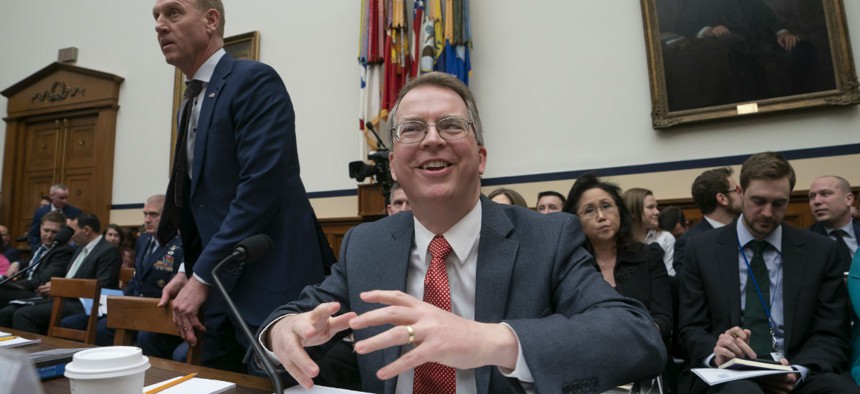
Comptroller and acting Deputy Defense Secretary David Norquist prepares to testify before the House Armed Services Committee. J. Scott Applewhite/AP
Pentagon Begins Moving Border Wall Money Despite House Objection
Acting deputy Norquist cites authorities while defending spending request and audit.
In the midst of a House hearing on the fiscal 2020 Defense budget on Wednesday, comptroller and acting deputy Defense Secretary David Norquist received confirmation that the $1 billion the Trump administration plans to transfer to build its southern border wall had already shifted to the Army Corps of Engineers.
The reprogramming—which the Pentagon is using for its controversial plan to draw from a long list of potential military construction and base improvement projects already funded—had been officially rejected on Tuesday in a letter to Norquist from House Armed Services Committee Chairman Rep. Adam Smith, D-Wash. “This decision was made after Congress, in good faith, approved and funded the department’s request based on discussion with the Army experts,” Smith said. “There are obviously more pressing issues with readiness and modernization that these funds could—and more importantly should—go to.”
But Norquist defended the authority for the moves in fielding multiple questions at the budget hearing that also dealt with the usual issues of wasteful spending, the Pentagon’s financial audit, and how the requested hikes in the $718 billion request for defense come alongside proposed cuts in domestic programs.
“There are two authorities,” Norquist said of the notification of the transfer sent to Congress on Monday. The law in U.S. Code Section 284 on “reprogramming “requires only a notification” and Section 2808 on military construction, for which “there is no proposal yet” for the planned $3.6 billion in transfers.
The clash with the Democratic-controlled Budget Committee sets up a likely legal battle over a plan this year and next to use as much as $12 billion in defense funds for the border wall.
Democrats cited recent complaints from Marine Commandant Robert Neller warning that the plan for “unplanned/unbudgeted Southwest border operations” could harm Marine Corps readiness, particularly in the form of cancelled training exercises in five countries.
But Norquist said press accounts of Neller’s statements “were wrong. Neller was concerned not with diversion costs for the border wall but with reprogramming of funds needed to repair military bases damaged by recent hurricanes.” He said the Pentagon had agreed on Monday to transfer $400 million for Marines base rebuilding, along with $200 million more to rebuild other bases.
Democrats from districts in Nevada, Texas and Virginia, where facilities currently slated for funding are on the list for potential delays, were skeptical. “Couldn’t a diversion of $1 billion for an imaginary crisis at the border, without permission, have been used for readiness?” asked Rep. Lloyd Doggett, D-Texas.
Norquist explained that the list of spending items being considered for delays was compiled based on their contract award date, beginning in January, so that “none that are scheduled to be awarded before Sept. 30,” when the fiscal year ends, will be affected. “The goal is not to cancel any of those projects,” he said, suggesting future funding. “There will be no delays or disruptions to readiness.”
But the comptroller declined to give a date for when the target list will be finalized, saying only that the specific needs request from the Homeland Security Department was now under review for legalities by the Joint Staff and others, which will finish sometime in April.
Rep. Steven Horsford, D-Nev., pressed Norquist for a written guarantee that none of the bases in his district would have their planned improvements delayed, and Norquist agreed, saying, “The merits of the individual projects will play a part in the determinations.”
Rep. Seth Moulton, D-Mass., contrasted the $12 billion being requested for a border wall versus only $9.6 billion in spending on cyber defense. “How many Russian and Chinese-launched cyber-attacks have we had in the last 24 hours?” Moulton asked. “A lot. How many attacks on the southern border?”
Norquist said only that China and Russia are not a concern on border, but other threats there are real.
In defending Trump’s proposal for larger defense budget hikes, Norquist said that before the arrival of the Trump administration, the department had “suffered blows to readiness,” and that it was important to “unto the damage” and “work together to protect those gains.”
He cited planned increases in “end-strength by roughly 7,700 service members” and a 3.1 percent military pay raise, “the largest in a decade.” Notably, he said, the requested $95 billion for research and development “is the largest RDT&E request in 70 years, and includes $3.7 billion for unmanned/autonomous systems, $927 million for artificial intelligence, and $2.6 billion for hypersonics.”
The comptroller defended the department’s first-ever full audit of its financial statement, which cost $1 billion, but is only “one sixth of one percent of the budget when you think of the size of the organization,” he said. An example of its impact is the Navy discovering that its inventory didn’t reflect all of the spare parts available, resulting in adding $80 million to the count. The audit “will pay for itself and help with better decision making by leadership,” he said, thanking members of Congress for “being big supporters of the audit.”







